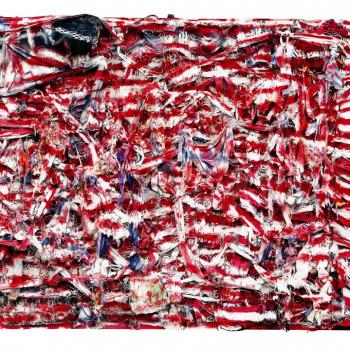Jesus said to Nicodemus:
“Just as Moses lifted up the serpent in the desert,so must the Son of Man be lifted up,
so that everyone who believes in him may have eternal life.”For God so loved the world that he gave his only Son,
so that everyone who believes in him might not perish
but might have eternal life.
For God did not send his Son into the world to condemn the world,
but that the world might be saved through him.
Whoever believes in him will not be condemned,
but whoever does not believe has already been condemned,
because he has not believed in the name of the only Son of God.
And this is the verdict,
that the light came into the world,
but people preferred darkness to light,
because their works were evil.
For everyone who does wicked things hates the light
and does not come toward the light,
so that his works might not be exposed.
But whoever lives the truth comes to the light,
so that his works may be clearly seen as done in God.John 3:14-21
 In honor of Brett’s recent interview with James Alison, one of Rene Girard’s most important interpreters, my reflection will draw on Girard’s rich insights into human psychology, anthropology and the biblical tradition. First, a brief and over-simplified primer:
In honor of Brett’s recent interview with James Alison, one of Rene Girard’s most important interpreters, my reflection will draw on Girard’s rich insights into human psychology, anthropology and the biblical tradition. First, a brief and over-simplified primer:
According to Girard, human desire is mimetic. We “catch” or borrow our desires from other people. Desire is also triangular, because it involves not just the formal object of desire – a new car, a job, prestige – but the person who models the desire for us. Within this triangular relationship, the object is merely an instrument that mediates our true desire. And what is that true desire? Girard says that all desire is a desire to be. We don’t really desire to have something, but to be someone, and that someone is the model, the one who has shown us what to desire.
As this mimetic relationship between subject and model is reciprocated, replicated, and intensified, it degenerates into a miasma of rivalry and destructive forms of idolatry. According to Girard, this psychological dynamic is at the heart of all human violence, and the sinful human solution to this drama, the generative mimetic scapegoating mechanism, is at the heart of all archaic religion and culture. It is generative because it creates renewed social solidarity and a sense of personal and collective righteousness. It is scapegoating because its random and structurally innocent victims become the repositories of the community’s sinful rivalries and violence.
The scapegoating mechanism is the “sin of the world,” according to Girard, and it is best summed up by the high priest Caiaphas: “It is better for you that one man should die for the people than for the whole nation to be destroyed.” Caiaphas intended for the cross of Christ to be just another in a long line of victim-events, a sop for the maddening crowd. But the divine mission of Jesus is to break the power and efficacy of the scapegoating mechanism, to take away the sin of the world. He accomplishes this by his teaching, his demonstration of divine power, his utterly compelling personality, and his obvious and absolute innocence on the cross. So convincing are all of these that even the Roman centurion at the foot of the cross is heard to exclaim, “Truly this man was the Son of God.”
Okay, on to today’s Gospel. Anyone who watches American sports is familiar with those ubiquitous, home-made signs that read “JOHN 3:16.” The idea is that this verse is a kind of capsule depiction of salvation history. That view is especially popular among Evangelicals, who often combine John 3:16 with John 3:7 (“You must be born again”) into a little formulaic bundle, a sort of Gospel in a nutshell.
That’s one way of thinking about this text, and I won’t quibble with it. But I would like to propose another. I suggest that the most important verses in today’s Gospel reading are the ones that immediately precede John 3:16: “Just as Moses lifted up the serpent in the desert, so must the Son of Man be lifted up, so that everyone who believes in him may have eternal life.” This is one of three passages in John in which Jesus refers to being “lifted up.” In John 12, he says, “Now is the time of judgment on this world; now the ruler of this worldwill be driven out. And when I am lifted up from the earth, I will draw everyone to myself.”
I’d like to suggest that in today’s Gospel Jesus is calling on us to adopt him as our model, as the true object of our desire. To shed all the sinful desires, false models and resulting rivalries and idolatries that keep us condemned to repeat the darkness of the mimetic contagion. From the beginning of his ministry, Jesus went out of his way to call attention to his person and encourage the kind of mimetic hero worship he knows is built into us. His first disciples ask, “Where do you abide?” He answers, “Come and see,” only to reveal that he is the one who abides in the will of his Father. And he invites them (and us) to “Abide in me.” He identifies himself as the “way, the truth and the life.” He says, “I am the light of the world. Whoever follows me will not walk in darkness, but will have the light of life.” Again and again, Jesus calls us into a mimetic relationship with himself, even conditioning eternal life on it.
On the cross, Christ was indeed lifted up, attracting the eye of the whole human race, drawing all men and women to himself “so that everyone who believes … may have eternal life.” I would suggest that to “believe” in Christ is not merely to give intellectual assent to a set of propositional statements or creedal formulations. No, saving belief in Christ is to take and hold him as our model, to desire nothing but him and his holiness, to appropriate his identity for ourselves: “I live, yet not I, but Christ lives in me.” This is how “the ruler of this world,” that “murderer from the beginning,” that “liar and the father of lies,” is driven out of our lives and out of our world. And if taking on the persona of Christ becomes difficult, St. Paul has the remedy: “Imitate me, even as I imitate Christ.” Through the saints we can imitate those who imitated those who imitated those who imitated Christ.
Thanks as always to my friend Gil Bailie, another of Rene Girard’s most important interpreters, for loaning me his insights.












